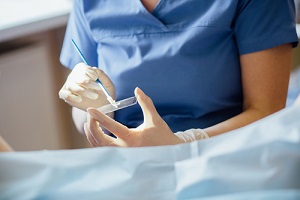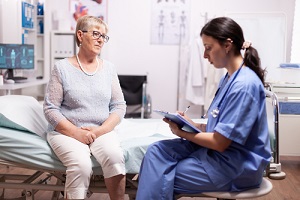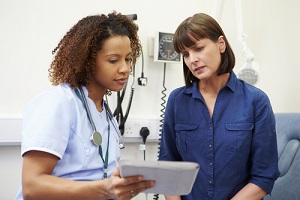 As an adult woman, routine Pap smear should be part of your healthcare routine. It is the best way for your doctor to detect signs of serious health conditions in your cervix, such as precancerous cells, or even cancer.
As an adult woman, routine Pap smear should be part of your healthcare routine. It is the best way for your doctor to detect signs of serious health conditions in your cervix, such as precancerous cells, or even cancer.
What Exactly Is A Pap Smear?
A Papanicolaou test, also called a “Pap” smear or Pap test, is a procedure that is performed in your gynecologist’s office, usually as part of a pelvic examination. A Pap smear tests your cervix for cervical cancer and precancerous cells. Your cervix is located at the lower, narrow end of your uterus at the top of your vagina.
To have a Pap test taken, you will be positioned lying down on the examining table to enable your doctor to access your cervix through your vaginal canal. The doctor gently slides a special tool called a speculum into your vagina to hold open the walls of the vaginal canal. Next, your doctor goes in with a tiny spatula or brush and wipes your cervix. This instrument takes some cervical cell samples that are sent to a lab to be tested.
Why Is A Pap Smear Necessary at All?
A Pap smear is the best way to screen for cervical cancer and other abnormal cells on your cervix. It is usually done in conjunction with your annual well woman exam.
When Should You Begin Having Pap Smears?
You should begin having Pap smears when you turn 21. Your doctor can give you a recommendation as to when you should begin Pap testing and how often you should have the test.
Why Is It A Good Idea To Have A Pap Smear Annually?
Annual Pap testing is the best way to detect cervical cancer early. Cervical cancer can be a deadly form of cancer. Early detection gives you a greater chance at a cure. Most women between 21 and 65 should have a Pap smear at least once every three years.
Even if no cancer cells are present, having routinePap smears can detect changes in your cervical cells that suggest cancer may develop in the future. Finding any abnormal cells early helps to prevent the development of cervical cancer.
In some cases testing for Human Papilloma Virus (HPV) is done in conjunction with the pap test. If you are one of many women who has specific risk factors, you should discuss with your doctor whether having Pap testing done more frequently is advisable.
 Common risk factors include:
Common risk factors include:
- Prior diagnosis of cervical cancer or precancerous cells.
- HIV infection.
- Weakened immune system due to organ transplant, chemotherapy, or chronic corticosteroid use.
- History of smoking.
Another reason to have Pap tests done regularly is to mitigate risks caused by false-negative tests. Pap tests are very reliable, but on rare occasions a patient can get false-negative results. A false-negative test means that the results show no abnormalities, but in fact there are changes in the cervical cells.
This can be caused by inadequate cell collection, insufficient amounts of abnormal cells to be identified in the test, or inflammation or blood obscured collection of abnormal cells. Because cervical cancer cells usually grow slowly, your next annual Pap test is likely to identify cell abnormalities early enough to treat it.
Are There Health Risks Associated With Having A Pap Smear Done?
A Pap smear presents very low health risks to the patient. Occasionally, you will feel discomfort, but no pain during the procedure. To minimize your discomfort, you should schedule your Pap test when you are not menstruating.
When Do You No Longer Need To Do Pap Testing?
You should continue getting Pap testing performed for as long as you are sexually active. You may no longer need to do so under the following conditions, but you should discuss your circumstances with your doctor:
1. You have had a total hysterectomy. A total hysterectomy means you have had your uterus and your cervix surgically removed for reasons not based on the presence of cancer or cancerous cells. If your hysterectomy was performed for a noncancerous condition, such as uterine fibroids, you may be able to discontinue routine Pap smears.
2. You are 65 or older. Some doctors suggest that routine Pap smears are not necessary for older women as long as their prior tests for cervical cancer have been negative.
Contact Raleigh Gynecology and Wellness to Schedule Your Pap Smear
If you need more information about Pap testing, consult with the experts at Raleigh Gynecology and Wellness. They are available to answer your questions about pap smears, pelvic examinations and any other issue pertaining to women’s reproductive health and wellness. Contact them to schedule an appointment.

 No two women will have the same experience when it comes to their period, but there is a range of what is considered normal in terms of cycle length, regularity, and flow.
No two women will have the same experience when it comes to their period, but there is a range of what is considered normal in terms of cycle length, regularity, and flow. 
 There’s a broad range of medications that can interfere with a woman’s menstrual cycle and cause menstrual disorders. These include blood thinners, epilepsy drugs, chemotherapy drugs, aspirin and ibuprofen, antidepressants, thyroid medications, and hormone replacement therapy.
There’s a broad range of medications that can interfere with a woman’s menstrual cycle and cause menstrual disorders. These include blood thinners, epilepsy drugs, chemotherapy drugs, aspirin and ibuprofen, antidepressants, thyroid medications, and hormone replacement therapy.  Menstruation is a cycle that involves the monthly shedding of the lining of the uterus, known as the endometrium, in the absence of pregnancy. Although this definition implies that menstruation comes with a certain sense of regularity and may be quite predictable for some women, it is a highly individual experience that not only varies widely from woman to woman, but also can be experienced differently from month-to-month. Here are some of the most common menstrual disorders.
Menstruation is a cycle that involves the monthly shedding of the lining of the uterus, known as the endometrium, in the absence of pregnancy. Although this definition implies that menstruation comes with a certain sense of regularity and may be quite predictable for some women, it is a highly individual experience that not only varies widely from woman to woman, but also can be experienced differently from month-to-month. Here are some of the most common menstrual disorders.  Amenorrhea is the absence of a menstrual period for longer than three monthly menstrual cycles.
Amenorrhea is the absence of a menstrual period for longer than three monthly menstrual cycles.  The specific treatments for a menstrual disorder will depend on your health, medical history, age, condition, symptoms, and the causes of the disorder.
The specific treatments for a menstrual disorder will depend on your health, medical history, age, condition, symptoms, and the causes of the disorder.  Most people instinctively want to see a doctor when they are experiencing unusual symptoms, such as bleeding between periods, pain in the pelvis region or abnormal vaginal discharge. While visiting an obstetrician-gynecologist (OB-GYN) is wise when experiencing complex or ongoing conditions, many common gynecologic problems can be diagnosed and treated by a nurse practitioner (NP).
Most people instinctively want to see a doctor when they are experiencing unusual symptoms, such as bleeding between periods, pain in the pelvis region or abnormal vaginal discharge. While visiting an obstetrician-gynecologist (OB-GYN) is wise when experiencing complex or ongoing conditions, many common gynecologic problems can be diagnosed and treated by a nurse practitioner (NP). There are many similarities between NPs and doctors, but these two professions also have distinct differences. The first difference is the education and training received by each group. Doctors generally go to school and train longer than NPs. According to the American Academy of Family Physicians, it takes an average of 11 post-secondary years of training and education to become a MD or a DO. In comparison, it takes about six to eight years to become a NP.
There are many similarities between NPs and doctors, but these two professions also have distinct differences. The first difference is the education and training received by each group. Doctors generally go to school and train longer than NPs. According to the American Academy of Family Physicians, it takes an average of 11 post-secondary years of training and education to become a MD or a DO. In comparison, it takes about six to eight years to become a NP. NPss that work in women’s health are equipped to provide many common services with or without supervision from a doctor. These services may include pelvic exams, sexual health counseling, contraception counseling, mammography referrals,
NPss that work in women’s health are equipped to provide many common services with or without supervision from a doctor. These services may include pelvic exams, sexual health counseling, contraception counseling, mammography referrals, 
 Enrolling in a Bachelor’s in Nursing Science degree is often the next step in a NP’s educational journey. If a nurse already has an ADN, he or she can choose to enroll in an accelerated RN-BSN program which can often be completed online. Bachelor programs in nursing typically include a clinical component where students are taught essential skills like communication, management, supervision, research and quantitative skills.
Enrolling in a Bachelor’s in Nursing Science degree is often the next step in a NP’s educational journey. If a nurse already has an ADN, he or she can choose to enroll in an accelerated RN-BSN program which can often be completed online. Bachelor programs in nursing typically include a clinical component where students are taught essential skills like communication, management, supervision, research and quantitative skills. Some patients may have concerns about seeing a NP over a doctor. Although NPs typically receive less training than a doctor, they are highly qualified to handle, diagnose and treat a wide range of ailments, physical issues and diseases. Patients can count on their NP to take on many of their medical needs, such as
Some patients may have concerns about seeing a NP over a doctor. Although NPs typically receive less training than a doctor, they are highly qualified to handle, diagnose and treat a wide range of ailments, physical issues and diseases. Patients can count on their NP to take on many of their medical needs, such as